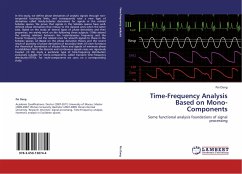
Introduction to Wavelets and Principal Components Analysis
with Applications in Mammography and Image Query
Versandkostenfrei!
Versandfertig in 6-10 Tagen
39,99 €
inkl. MwSt.

PAYBACK Punkte
20 °P sammeln!
Wavelet analysis found to have a variety of applications. While other transforms such as the DCT may achieve a better compression ratio, their rule of zeroing small coefficients is applied evenly and globally while in wavelet analysis, the rule of zeroing can be applied locally, preserving small coefficients that account for important minute features (such as in fingerprints).Starting with an introduction to wavelet analysis and some related concepts useful for classification the book provides a coverage of the theory and mathematical foundations of wavelets, the Best Basis, the Joint Best Bas...
Wavelet analysis found to have a variety of
applications. While other transforms such as the DCT
may achieve a better compression ratio, their rule
of zeroing small coefficients is applied evenly and
globally while in wavelet analysis, the rule of
zeroing can be applied locally, preserving small
coefficients that account for important minute
features (such as in fingerprints).
Starting with an introduction to wavelet analysis
and some related concepts useful for classification
the book provides a coverage of the theory
and mathematical foundations of wavelets, the Best
Basis, the Joint Best Basis, Principal Component
Analysis and the Approximate PCA as well as the
application of these tools to derive feature vectors
for the classification of mammographic images.
This book will be useful as a reference text and
will benefit both the audience whose interest is at
the conceptual level, as it provides a qualitative
description of the underlying ideas of wavelet
theory and the audience who is interested also in
the theory and mathematical foundations of wavelet
analysis and its applications.
applications. While other transforms such as the DCT
may achieve a better compression ratio, their rule
of zeroing small coefficients is applied evenly and
globally while in wavelet analysis, the rule of
zeroing can be applied locally, preserving small
coefficients that account for important minute
features (such as in fingerprints).
Starting with an introduction to wavelet analysis
and some related concepts useful for classification
the book provides a coverage of the theory
and mathematical foundations of wavelets, the Best
Basis, the Joint Best Basis, Principal Component
Analysis and the Approximate PCA as well as the
application of these tools to derive feature vectors
for the classification of mammographic images.
This book will be useful as a reference text and
will benefit both the audience whose interest is at
the conceptual level, as it provides a qualitative
description of the underlying ideas of wavelet
theory and the audience who is interested also in
the theory and mathematical foundations of wavelet
analysis and its applications.












